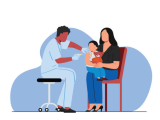Jun 13, 2003 (CIDRAP News) Wisconsin health officials confirmed today that they are investigating two possible cases of person-to-person transmission of monkeypox, but said the cases seem unlikely to be confirmed.
The suspected cases were reported in a Milwaukee nurse and a staff member at the Marshfield, Wis., Clinic, which reported the first case in the monkeypox outbreak. "I'd say its highly likely that neither one has monkeypox virus infection," State Epidemiologist Jeffrey Davis, MD, said at a telephone press briefing this afternoon.
The reports surfaced as the number of suspected or confirmed cases nationwide increased to more than 80 today. The Centers for Disease Control and Prevention (CDC) counted 72 cases, including 33 in Indiana, 21 in Wisconsin, 17 in Illinois, and 1 in New Jersey, spokeswoman Jennifer Morcone told CIDRAP News. She said the CDC had confirmed 13 of those cases by laboratory testing.
In the Wisconsin briefing, Davis said 13 more suspected cases were added to the state's count today, bringing the total to 34. (The additional Wisconsin cases would bring the national total to 85.) Four Wisconsin cases have been confirmed, 10 are classified as probable, and 20 are suspected, he said. Fourteen of the 34 cases are in veterinary clinic workers, while 8 involve people who work in or visited pet shops, Davis said. Seven cases are in people with household exposure to prairie dogs.
Davis described the illness cases involving possible person-to-person transmission as mild. The Milwaukee nurse took care of a patient with what turned out to be a confirmed case of monkeypox, but she used careful infection control precautions, he said. She had about 30 minutes of contact with the patient Jun 3 and came down with symptoms about 5 days later. Symptoms included a fever of 100º F, a runny nose, a nonproductive cough, a sore throat, and one small lesion on her hand.
The Marshfield Clinic staff member did an intake examination of the child who turned out to have the index case of monkeypox in the outbreak, Davis said. In examining the child on May 22, and again a week later, the woman did not use infection control measures, he reported. Starting Jun 10, the worker experienced a headache, backache, chills, some muscle weakness, and diarrhea, but no rash and only slight fever. On Jun 11 her boy friend had onset of a small, superficial rash, plus chills, a slight headache, and diarrhea. Both patients are now doing well, Davis said.
The fact that the clinic worker and her boy friend experienced a similar illness at about the same time suggests something other than monkeypox, according to Davis. "You'd have to expect an additional incubation period if her boy friend caught monkeypox from her," he said.
Monkeypox, which resembles smallpox but is milder and less infectious, was never seen in the Americas before cases were reported in the Midwest last week. The disease has spread to humans from prairie dogs, which may have been infected by a Gambian giant rat imported from Africa. In human monkeypox outbreaks in Africa, limited person-to-person transmission has occurred. A CDC report of a 1990s outbreak in the Congo said that about 8% of household contacts of patients contracted the illness.
In other comments at the briefing, Davis said the epidemiologic investigation in Wisconsin suggests that no fewer than 18 monkeypox cases in the state stem from one prairie dog. "That one prairie dog has been associated with more than half the cases in our statea super shedder if there ever was one," he said. Investigators traced the prairie dog's trail from a pet store to a household and on to two different veterinary clinics before it died, he explained.
See also:
Wisconsin Division of Public Health monkeypox page
http://dhfs.wisconsin.gov/communicable/MonkeyPox/
CDC monkeypox resources
http://www.cdc.gov/ncidod/monkeypox/index.htm


















